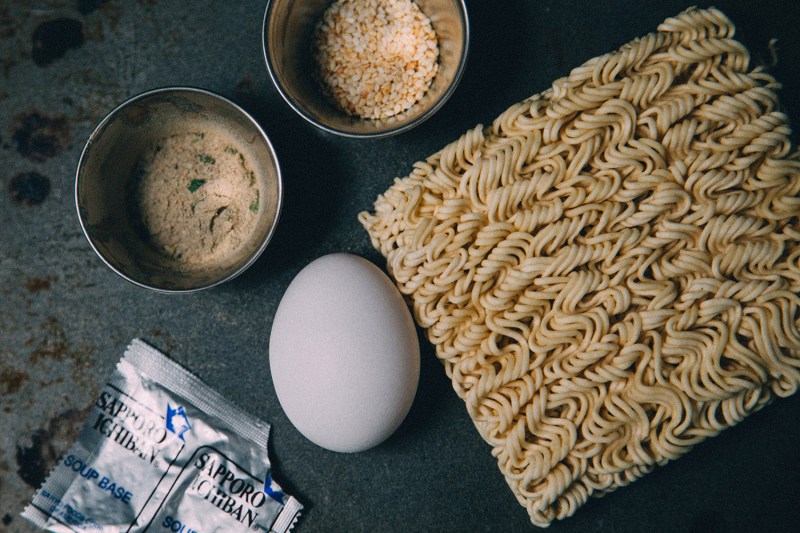
Coming into true adulthood is a mixed bag of emotions. While the perks of bigger bank accounts, spaces to call our own, and the ability to appreciate really good wine are beautiful things, it’s perfectly normal to find oneself nostalgic for simpler times. For most of us, gone are the good ol’ days of few responsibilities, hangovers that magically vanish in no time, and living off 5-for-a-buck packages of instant ramen. And while we can’t do anything about the hangovers (sorry), we can give ramen noodles an adult upgrade.
Now that your kitchen (hopefully) consists of more than a greasy microwave shared with five other students, it’s time to view instant ramen as the insanely convenient, perfectly delicious ingredient it is. For the most part, we’ve outgrown the version that’s simply boiled to death and then sprinkled with a packet of delicious MSG magic (though we won’t lie — this dish still slaps at 2 a.m. after a long night). So how do we turn this coming-of-age staple into fare fit for grown-ups?
Sure, there are countless instant ramen noodle recipes out there, but with a pretty basic guideline, you won’t need any of them. Learning how to make ramen the way you like it is key, and that means adding anything you want to that package of instant noodles. But we do have a few suggestions for some of the best things to add to ramen …

How to elevate your ramen
Forget the foil
For starters, toss the foil flavor packet. We know it’s delicious. But it’s also a dead giveaway that what you’re making isn’t homemade. And no, just because you boiled water doesn’t mean you get to take credit for being a chef. So toss it. To really elevate your ramen recipes, cook your noodles in broth or stock that complements your dish — beef, chicken, vegetable, and seafood all work beautifully, depending on your other ingredients.
Beef it up
Next, decide on a protein. To make your ramen dish a complete meal, and one comparable to one you’d order in a restaurant, you’ll want to bulk it up with a little protein. Pork belly is a classic choice for ramen, but you can use just about anything you please. Grocery store rotisserie chicken is a wonderful, easy addition, and no one has to know you didn’t roast the bird yourself. Shrimp and salmon are deliciously easy seafood options that you can add to your ramen either pre-cooked or raw, allowing them to cook in the simmering ramen broth. Of course, meatless alternatives like tofu are wonderful in ramen as well.
Eat your veggies
Once you’ve decided on a protein and complementary broth, you can get creative with your other ingredients. Classic vegetables in ramen dishes include bok choy, mushrooms, spinach, green onions, and bean sprouts. Shredded carrots and red bell peppers add gorgeous color as well.
Get saucy
This part is fun. You know all those sauces in your refrigerator door you haven’t used in months? This is their moment to shine. To flavor your ramen, you can add any number of sauces or condiments — like Korean kimchi, chili sauce, hot sauce, fish sauce, sriracha, sambal, or anything you please! The world is your oyster sauce.
One of our favorite combinations is peanut butter and soy sauce for a very Thai-inspired flavor.
Those are some of the easiest suggestions for making your ramen something you actually want to share with people, instead of slurping it alone while you watch Netflix. You say you want more suggestions? Keep reading …

Be extra – eggs aren’t just for breakfast
If you don’t add an egg to your homemade ramen dish, what are you even doing with your life? Okay, look, we know it’s trendy, but there’s a good reason for it. Beautifully runny eggs are on top of everything now, from pizza to sandwiches, and, yes, ramen. But that drippy golden yolk is straight from the gods and we refuse to feel guilty about wanting it on everything. Including our ramen.
Our favorite way to add an egg is to crack a fresh one directly on top of the simmering ramen as it finishes cooking. Be sure that it’s only at a gentle simmer; otherwise, your egg will come apart before it cooks. Simmer this way for about 5 minutes until you’ve reached eggy ecstasy.

Make your own spice blend
So we kicked this ramen adventure off by telling you to toss the spice packet. But if you really miss the little foil-wrapped burst of flavor, you can recreate that flavor in a way that avoids a ton of that blood-pressure-boosting sodium (yes, you need to think about stuff like that, you’re not a kid anymore).
So if you want your ramen to have that classic flavor, but in a healthier way, try this recipe from This Healthy Table.
Ingredients
- 3 chicken bouillon cubes
- 2 teaspoons garlic powder
- 1 teaspoon onion powder
- 1 teaspoon dried parsley
- 1/2 teaspoon ground cumin
- 1/2 teaspoon ground ginger
- 1/2 teaspoon ground black pepper
- 1/2 teaspoon kosher salt
Method
Stir all the ingredients together and store the spice blend in a sealed container.



